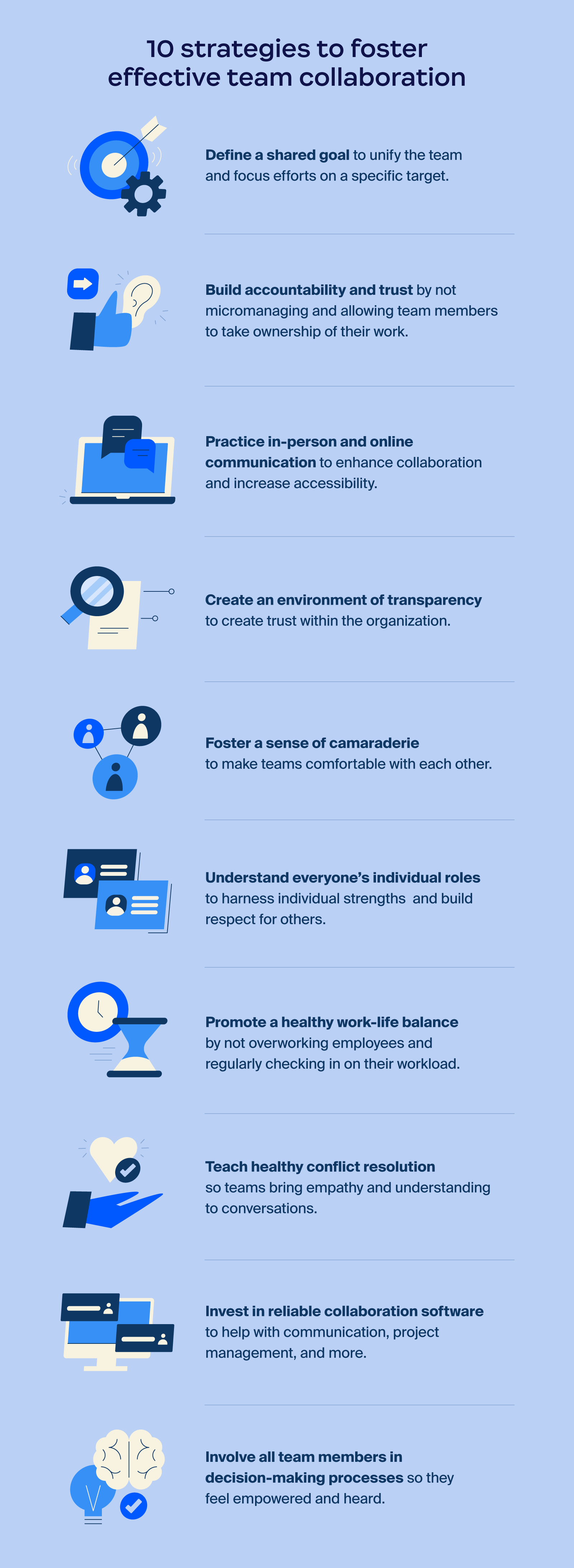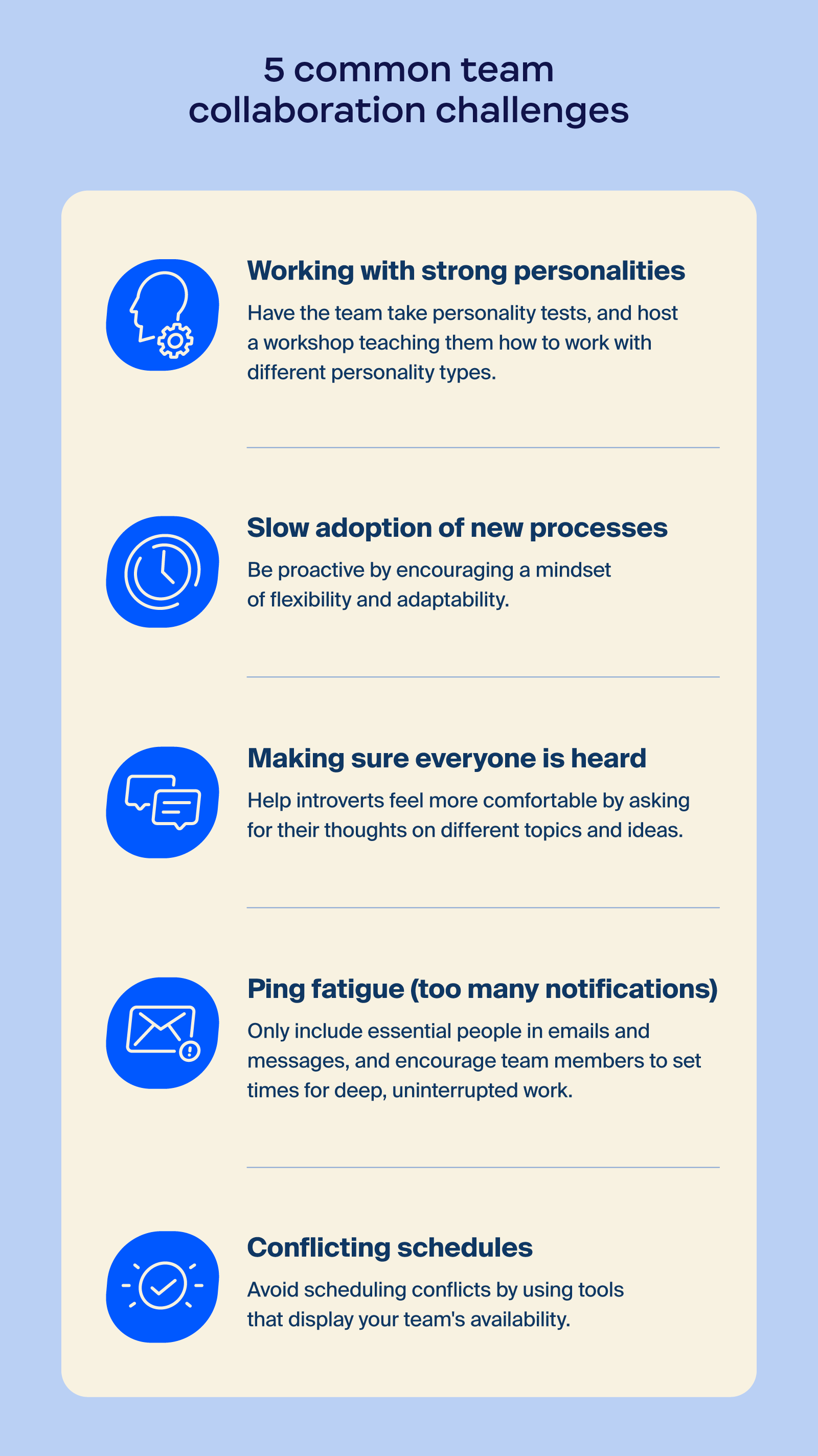
Meet Zoom AI Companion, your new AI assistant!
Boost productivity and team collaboration with Zoom AI Companion, available at no additional cost with eligible paid Zoom plans.
Updated on February 19, 2025
Published on February 19, 2025


Effective team collaboration is the foundation of projects and plays a crucial role in an organization’s overall success. When teams work together seamlessly from a place of trust and respect, they can achieve remarkable results. However, when collaboration falters, projects can stale, morale can drop, and productivity can suffer.
In this post, we’ll explore the importance of team collaboration, delve into practical strategies to foster strong teamwork, and discuss common challenges teams face and how to overcome them. But don’t just take our word for it — we’ve consulted executives from various industries for their thoughts and advice on teamwork strategies.
Team collaboration is the process of working as a group to achieve a common goal. Successful team collaboration depends on sharing ideas, knowledge, and skills to create something greater than what could be achieved individually. This can involve groups within a department or cross-team collaboration with other departments or external teams.
Each person should actively participate, have mutual respect for others on the team, and be willing to compromise. When team members listen attentively to one another’s ideas and give transparent and constructive feedback, they can learn from others and improve their own skills.
I believe transparency starts with leaders being authentic. I make it a point to share not just the wins but also the challenges we face as an organization[…] Trust isn’t built overnight, but consistent openness makes a world of difference.
If you want to enhance your team’s collaborative spirit, boost productivity, and strengthen your organization, you need a game plan. By implementing the following 10 strategies, you can foster an effective, collaborative environment that helps your team to achieve more together.

Define a shared goal that provides a clear direction and purpose for the team. This brings people together and aligns everyone’s efforts with a specific target in mind. With shared goals, teams feel a sense of unity, motivating individual members to work toward a common objective. You might consider linking goals to KPIs, like increasing sales by 10% within 90 days, so the team has something specific to work toward.
Pro tip: Use the S.M.A.R.T. method, making goals specific, measurable, attainable, relevant, and time-based.
Micromanaging stifles creativity and can hinder your team’s success. By building a culture of accountability, you empower team members to take ownership of their work and make independent decisions. Give your team the necessary resources, tools, and support, but resist the urge to constantly intervene by trusting your team’s expertise to get the job done.
Pro tip: Rather than hovering and micromanaging, actively engage in regular coaching sessions, provide constructive feedback, and offer guidance when needed. Celebrate successes and frame setbacks as learning opportunities to build a strong foundation so your team members can thrive.
With flexible work on the rise, effective communication strategies are more important than ever. It’s crucial to have the right communication channels that allow team members to collaborate, whether they’re at the office or working remotely. Team collaboration tools can include project management software, instant messaging, video conferencing, and more.
Pro tip: People have different communication styles. Some may be more comfortable typing, while others may prefer talking face-to-face or on a call. Ask for each person’s preferences so team members don’t avoid communication.
At ENX2 Marketing, a strong culture of collaboration has been a cornerstone of our success. By holding bi-daily video calls, we ensure complete team alignment and have fostered an environment where creativity thrives.
Trust is an essential component of team collaboration, and that starts with transparency from the top. When everyone in leadership, from the CEO to middle management, leads by example with transparency, employees have better insight into decisions and operations, giving them the space to trust and be transparent as well.
Pro tip: Regular all-hands meetings are a great place to showcase transparency and lead by example. Here, leaders can speak openly about the company’s successes and challenges while also explaining why they made certain decisions.
Collaboration among employees begins with team members feeling at ease with one another. You can help create a more comfortable environment where employees can get to know each other through icebreakers, office get-togethers, and company outings. Team members who are comfortable with each other collaborate better and are more willing to give and receive constructive feedback to meet shared goals.
Pro tip: Even if your team works remotely, schedule group get-togethers where people can chat and play games virtually.
Each person has a distinct role within a team, and it’s important to value each person’s strengths and weaknesses while fostering a culture of appreciation and mutual respect. For example, someone on the team may be good at crunching numbers, while another is an excellent writer. They might collaborate to make a presentation, with one extracting data and the other putting that data into words, explaining why it’s important.
Respecting everyone’s strengths and weaknesses allows people to shine in some areas and ask for help in others. Using the previous example, the writer should feel comfortable enough to ask the person running the numbers for clarification on certain data points. This helps with group collaboration by encouraging team members to support one another.
Pro tip: Lead by example by asking for help when you need it. This not only shows humility but also builds confidence in those who provide assistance.
Teams succeed when mental health is a priority, and a major part of this is a healthy work-life balance. Encourage balance by not overworking employees, keeping an especially close eye on team members who tend to work after-hours to make sure they aren’t on a path to burnout.
According to recent hybrid work statistics, 95% of business leaders say they’ve provided employees with more flexibility. This may involve allowing employees to work from home or implementing a hybrid work model. You’ll soon find that when team members have more flexibility, it helps them maintain their well-being while getting the job done.
Pro tip: Regularly check in with your team members to see how their workload feels. It may look like they have a balanced week from your point of view, but challenges arise that can delay projects or lead to extra hours. Work with team members to move projects around so they’re not overworked and can wrap up work on time.
When tensions run high, it’s important to have healthy conflict resolution strategies in place. Each team member should practice empathy and make an effort to understand where others are coming from. If need be, it’s never a bad idea to take a break, reset, and return to the conversation with a better mindset and willingness to compromise.
Pro tip: Returning to the shared goal and reminding team members what they’re working toward is a great way to put personalities to the side, rekindle the camaraderie, and find solutions.
Team collaboration software encompasses more than just team chat tools. Many tools help with project management to keep team members organized and on task, and allow for file sharing and collaborating within documents.
Pro tip: Make sure your teams have the tools they need to communicate effectively regardless of where they’re located.
Zoom is great for spontaneous problem-solving. Quick check-ins or brainstorming sessions on Zoom can mimic the natural flow of in-office collaboration, making remote work more productive and personal.
People feel empowered when they feel like they’re part of the decision-making process, as it instills a sense of ownership and responsibility and makes team members feel heard and valued. By actively incorporating each team member’s perspective, you gain valuable insights and demonstrate your trust and respect for their expertise.
Pro tip: Some of the best ways to get team members involved in decision-making is to have them help brainstorm solutions to challenges or give input on project goals. You can also ask them to give input on the best way to tackle different projects so you can test different methodologies.
Proper team collaboration drives innovation and helps achieve organizational goals. Below, we explore the benefits for both individuals and organizations.
Effective collaboration creates a positive work environment where team members feel valued and supported. When individuals feel connected to their team and empowered to contribute, it naturally boosts their morale. And when morale is high, employees have improved well-being and overall job satisfaction.
Collaboration is the lifeblood of every team, not just to build a stronger business, but to keep people feeling happy and connected to the people around them. As humans, we all need that to stay happy, healthy, and engaged in what we do.
Team collaboration encourages sharing knowledge and cross-pollination of ideas, bringing out a culture of creativity and innovation. Working together allows team members to learn from one another’s expertise, identify opportunities for improvement, and develop innovative solutions. This collective knowledge base enhances problem-solving abilities and team performance as everyone works toward shared goals.
It’s difficult for an individual to do everything on their own, and it’s often a less efficient way to complete projects. Collaboration streamlines workflows by eliminating communication silos and reducing the time spent on different tasks. Teamwork helps identify and resolve issues quickly, leading to faster project completion and increased productivity.
Leaders play a crucial role in efficiency by delegating tasks and playing to each person’s individual strengths. For example, if someone has expertise in a topic, they can put a presentation together faster because they don’t need to spend as much time researching it.
Team collaboration encourages open and honest communication, which improves decision-making and reduces misunderstandings. Teams that engage in open dialogue are generally more comfortable sharing ideas freely and addressing challenges proactively.
While team collaboration offers numerous benefits, it’s not without its challenges. From personality clashes and communication breakdowns to conflicting priorities and different work styles, teams can encounter obstacles that hinder their progress.
Below, we unpack some of the most common challenges and provide tips to overcome them.

Strong personalities can sometimes clash, causing tensions to arise and disrupting the flow of the entire team. Different communication styles, work habits, and expectations can create friction and hinder collaboration.
Team-building tip: Have the team take personality tests, then host a team workshop using Zoom Whiteboard to show how different personalities can work together by better understanding one another. For example, more dominant personalities can proactively anticipate potential conflicts and have strategies ready to resolve them.
You could be met with resistance when implementing new processes or tools, especially if they disrupt existing workflows or require additional training. People can be hesitant toward change, and, in some cases, team members may be unsure about the benefits of the new tools or processes. This can slow down workplace collaboration and hinder progress.
Highlighting how tools solve specific team challenges and sharing quick success stories can boost enthusiasm and adoption effortlessly.
Team-building tip: Be proactive by encouraging a mindset of flexibility and adaptability. In addition to conducting training sessions, make sure someone from each team is well-versed in the process by providing them with extra training so they can support other team members when they have questions.
Those who don’t feel heard or valued may stop contributing their much-needed ideas to the project. This challenge can intensify on larger teams due to a larger volume of input. Without a safe and inclusive environment, people feel less comfortable speaking up or asking for help.
Team-building tip: It’s common for more extroverted people to dominate conversations. Each team is likely to have introverts or people who simply don’t feel comfortable speaking up, so it’s important to make sure everyone’s thoughts are heard. You can do this by encouraging input outside large meetings to avoid putting people on the spot.
With the various chat apps and project management tools involved in remote and flexible work, people regularly receive notifications on their computers and phones. Constant notifications and interruptions can lead to lower productivity and difficulty focusing. Too many messages and emails can overwhelm team members, resulting in burnout, decreased efficiency, and frustration.
Team-building tip: Encourage team members to set aside time for deep work where they can turn off notifications. Zoom Team Chat allows your team to set their status to “Busy” or “Do not disturb” for a specific duration, letting others know they’re heads-down working on a project.
Conflicting schedules can impact team collaboration, especially if you have team members in different time zones and working remotely. This can lead to communication breakdowns, missed deadlines, and difficulty scheduling meetings. When team members can’t connect and collaborate in real time, it’s difficult to share information and address challenges promptly.
Team-building tip: Use Zoom Scheduler to see everyone’s availability so you can make sure people can make it to important meetings. When meetings are necessary, make sure they’re structured. Schedule brainstorming and mind-mapping sessions to gather ideas and have discussions.
Don’t let meetings turn into monologues. Assign roles or discussion points beforehand so everyone comes prepared to contribute. When meetings are interactive, collaboration flows naturally and the energy stays high.
Team collaboration is the cornerstone of success in modern work environments. Fostering a collaborative spirit and implementing the strategies outlined above can allow your team to achieve remarkable results. However, building a strong collaborative team requires the right tools.
With Zoom Workplace, your team has access to an entire suite of collaborative tools — Team Chat, Meetings, Scheduler, and other features enable teams to communicate and share files seamlessly. Each feature is specifically designed to help teams collaborate efficiently and effectively, whether your team works in the same office or from home.
Take advantage of Zoom Workplace today to access these tools and take your team’s collaboration to the next level.